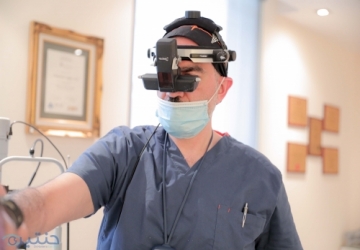
Dry eyes
it is one of the most common diseases in ophthalmology, and according to several studies, the prevalence of dry eyes among the population is about 15%, while the prevalence rate among contact lens wearers increases to 50%.
Dry eye symptoms
Conjunctival dryness in itself is one of the pathological symptoms and not a disease, but it is often accompanied by one or more of the following symptoms:
• Feeling of stinging, itching or burning in the eye.
• Mucus in the form of a thread around or inside the eye.
• Eye fatigue after reading, even if for a short period.
• Difficulty using contact lenses.
• Blurring of vision that worsens at the end of the day or after focusing the eyes for a continuous period on one point.
Causes of dry eyes
With the question of Dr. Muhammad Hantira - Honorary Assistant Professor - Department of Ophthalmology - Umm Al-Qura University - Saudi Arabia
He assured us that most of the time drought occurs with age as a result of the lack of tear production, which in turn occurs due to some changes, including:
• Hormonal changes.
• Inflammation of the eyelids, which affects the sebaceous tear glands, and it is one of the common causes.
• Exposure to a hot or windy climate.
• Long-term use of contact lenses.
• Performing laser and LASIK eye correction operations.
• Looking at the computer and cell phone for extended periods.
• The use of some medicines, the most important of which are those that are used to treat acne.
• Some immune diseases linked to dehydration, such as rheumatoid arthritis and Sjogren's syndrome.
Dr. Hantira explained:
There are a number of tests that can diagnose dry eyes, including:
• Examination under a microscope to inspect the eyelids and the surface of the cornea.
• Tear test using fluorescein dye.
• Check the amount of tears.
• Checking the osmolarity of tears and determining the percentage of tear salinity.
• Check the speed of evaporation of tears.
Dry eye treatment:
• Use moisturizing eye drops and ointments, especially those that do not contain preservatives.
• Cleaning the eyelids and massaging the eyelids.
• The use of cyclosporine drops to increase the number and secretions of tear cells.
• The use of permanent and temporary tear duct plugs to keep the tears inside the body.
• The use of intense light pulses to stimulate the fatty tear cells.
Dr. Hantereh noted:
What is new in treating dry eyes is
An E-Eye device is a device used to stimulate fatty tear cells through intense light pulses.
The patient has three sessions, so that the interval between the first and second sessions is 15 days and between the second and third sessions 30 days.
The day when the symptoms of dry eyes improve significantly after the first session and the sessions continue to work for about
From three years. The procedure is safe and is performed in the outpatient clinic without pain for a period of not more than five minutes.
Prevention of dry eyes
Dr. Hanatera advised the need to prevent dry eyes, and this may happen in several ways, including:
Protecting the eyes from direct stimuli such as wind, dehydration, and various chemicals. And that by goggles or swimming goggles.
Periods of rest during the performance of activities that require constant attention focus.
Placing the computer screen in a place lower than the level of the eyes, in order to avoid the eyelids opening too much.
To stop smoking or not to be exposed to smoke.